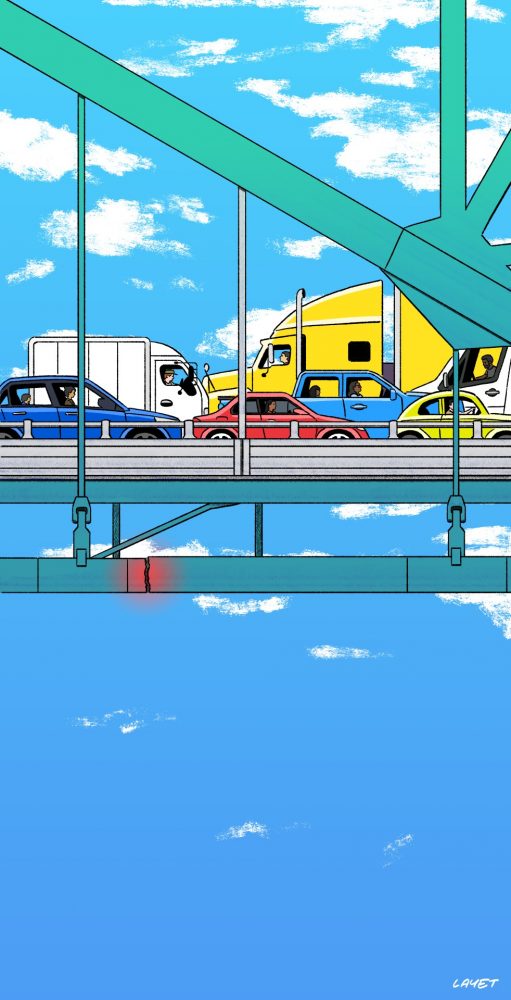
On May 11, a catastrophe was narrowly averted on the I-40 Hernando DeSoto bridge, a 3.3-mile-long structure that crosses the Mississippi River and connects Memphis and Arkansas.
A contractor working for the Arkansas Department of Transportation (ArDOT) noticed a gaping crack in a hollow steel girder, threatening the entire bridge span with collapse. The situation was so dire that the contractor called 911, and authorities shut down traffic within hours. It remained closed for three months while workers performed emergency repairs, costing roughly $10 million.
ArDOT later determined the crack had been visible since at least 2016, according to an amateur photograph taken by a kayaker on the river, 120 feet below. Somehow, despite annual inspections of the bridge, ArDOT had missed it time and time again.
Nine months later, after a federal review and an internal investigation, ArDOT is in the process of implementing major changes to its inspection program that will result in vastly improved oversight. In December, the Federal Highway Administration instructed state transportation agencies across the country to evaluate their bridges for similar vulnerabilities.
As for the I-40 bridge itself, it has never before received such careful attention. During the closure last summer, crews scanned some 500 welds with ultrasonic technology. (Steel plates were installed in 17 spots as a precaution, though no other major defects were found.) Further testing is scheduled for this spring or summer, according to ArDOT spokesman Dave Parker.
But how did the situation become so dire? And who was responsible for missing such an obvious flaw on a bridge that sees 41,000 vehicles cross its span on a given day? A close analysis of an engineering report and interviews with state officials offer some insights.
The key takeaway: Inspection missteps on the bridge may date back four decades.

A critical link
The Hernando DeSoto Bridge was constructed in 1973 and is a vital component of the I-40 federal interstate highway, which stretches from Barstow, Calif. to Wilmington, N. Car. Its failure would have amounted to a catastrophe that would be hard to imagine.
The cracked girder was blamed on a flawed weld — something that plagues similar bridges across the nation due to welding practices that are no longer acceptable today.
Failure of this “fracture critical” element would be expected to cause the bridge span as a whole to collapse. Fracture-critical members are supposed to be given an arms-length inspection every year — that is, inspectors should be close enough to reach out and touch the flawed area.
ArDOT initially blamed one employee, inspector Monty Frazier, who was fired on May 17. Since 2016, Frazier had been part of a team that inspected the bridge, and he led it in 2019 and 2020.
In an interview in July, ArDOT Director Lorie Tudor said Frazier was “the only inspector who looked at that particular tie girder” between 2016 and 2020, even though inspection reports showed otherwise. ArDOT later acknowledged a different inspector had examined the girder in 2018; that employee was “verbally counseled” and received additional training, Parker said in November.
Many specific questions remain about how the crack was missed in recent years, some of which may be answered by an ongoing federal investigation by the U.S. Department of Transportation’s Office of Inspector General. But other information has emerged that gives a sense of the broader inspection failure and how the crack developed.
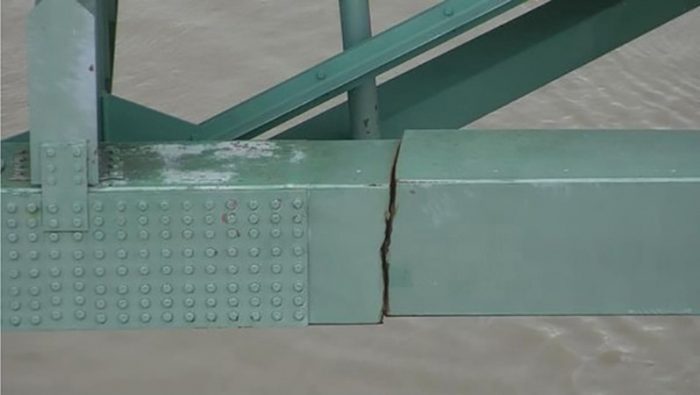
In November, ArDOT released a Federal Highway Administration review of ArDOT’s bridge inspection program and the results of an internal investigation that recommended placing the program under new management. Two senior ArDOT engineers who oversaw the heavy bridge maintenance section, Mike Hill and Stewart Linz, “retired” that same day.
It also released a third document: a detailed forensic analysis of the crack by Wiss, Janney, Elstner Associates, a Chicago-based engineering firm.
In May, the damaged portion of the girder was removed from the bridge and sent to WJE’s laboratory in Illinois for metallurgical analysis. The 43-page final report delves into the literal minutiae of the fracture — its structure on a microscopic scale — to explain how the crack developed.
The WJE report ties the bad weld back to the original fabrication of steel plates in the late 1960s or early 1970s.
The report focuses on the material causes of the fracture, but it also underscores the scope of the historical inspection failure. Highway authorities have long known the bridge was vulnerable to cracking based on its design, its materials and the period when it was built.
Perhaps most remarkably, the WJE report indicates that a contractor hired by Tennessee highway authorities missed a chance to find the problem almost four decades ago. (Tennessee and Arkansas co-own the bridge and split the costs of maintenance; in general, Arkansas is responsible for inspections and Tennessee is responsible for repairs.)
The crack wasn’t visible to the naked eye at that time, presumably. But in 1982, the Tennessee Department of Transportation performed ultrasonic testing on many of the bridge’s welds, including the specific site where the fracture would later develop. That weld was found to contain a minor defect, which was noted in a report from the time.
The ultrasonic test did not, however, find two other, much larger defects a few inches away in the same weld. Those cracks, lurking unseen beneath the surface of the metal, would eventually develop into the gaping fracture that became visible in recent years.
“We cannot explain how the flaws were missed in 1982,” Parker said in an emailed response to questions about the WJE report. “Based on WJE’s findings, the flaws should have been detectable during the 1982 evaluation.”
Ted Kniazewycz, the director of the Tennessee Department of Transportation’s structures division, said the defects were likely missed because the weld site was unusually wide, due to repairs done during fabrication. “When they were testing the weld, they just didn’t test a big enough area,” he said.
WJE referred all questions about its analysis to ArDOT. The contractor that performed the 1982 ultrasonic test, the Magnaflux Corporation, did not respond to requests for comment.

Hidden flaws
If cracks are found in a structure early on, experts said, they often can be addressed with little disruption.
“If you don't maintain your home, you're going to start getting leaks,” said Gary Prinz, an associate professor of civil engineering at the University of Arkansas who specializes in steel fatigue and fractures. “That doesn't mean that it wasn't built or designed properly. It just means, you know, things happen over time. Just like you would in your home, we do normal repairs and inspections of critical elements to ensure that it continues to operate adequately and to ensure safety.”
Ruchu Hsu, a retired structural engineer who has designed multiple bridges in the U.S. and abroad, said design and construction standards have improved in the 50 years since the I-40 bridge was built. One shouldn’t assume older structures are unsafe, however. They just require diligent inspection.
“Finding a crack on this bridge, it’s a normal thing. It’s nobody’s fault,” Hsu said. “The design was basically good at that time. The construction was good at that time. The only thing, in my view, the only problem, was the inspection.”
The twin arches of the I-40 bridge are examples of a “tied-arch truss” design. The ends of each arch are “tied” together by girders that run along either side of the bottom of the bridge deck. These tie girders hold the arch in tension, much like the ends of a longbow are held together by a string. (A tied arch is sometimes called a “bowstring arch” for this reason.) That means the failure of a tie girder could cause the entire structure to unravel.
On the I-40 bridge, the tie girders are composed of steel plates welded together to form a long, hollow box. The fracture developed within a weld that joins two plates — one thicker, one thinner — both on the front face of a tie girder on the north side of the bridge. The girder runs beneath the bridge deck, below the traffic streaming westbound from Memphis to Arkansas.
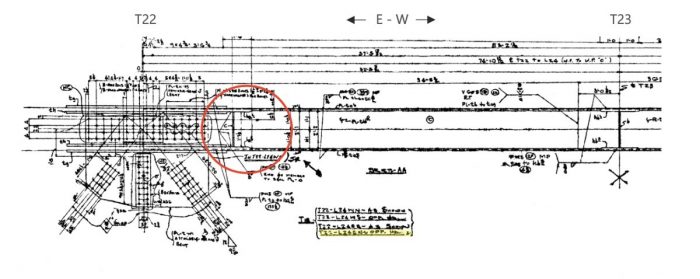
The WJE analysis found that two large cracks developed deep within the weld — or, more precisely, within repairs made to the weld during fabrication. The cracks were caused by hydrogen gas building up in the weld metal, a common problem that can be mitigated by practices such as pre-heating the base metal before welding.
Today, the report says, metal fabricators adhere to strict hydrogen control measures and test welds for cracks after a weld is complete. “However, during the era when these tie girders were fabricated, such measures were not fully understood or practiced,” the report says.
Prinz said welding standards have evolved significantly since the 1970s.
“For our new infrastructure going in, there are fracture control plans that are put into place to capture these sorts of weld defects in the fabrication shops,” he said. “And on the back end, post-fabrication or post-erection inspection criteria is specially designed to capture issues like this before they become critical. When followed.”
The WJE report constructs a step-by-step narrative of how the two cracks propagated through the surrounding metal — the growth arresting for a time, then resuming. Eventually the fracture broke through the surface of the metal and became visible on the exterior face of the tie girder.
What the report does not contain, however, is a sense of when that happened. ArDOT has acknowledged the crack could be seen from a distance in 2016. Could it have been visible even longer? Another amateur photo from 2014 that appears to show the crack, published last summer by the Arkansas Nonprofit News Network and The Daily Memphian, has not yet been verified by authorities.
The question is important because ArDOT has insisted the crack went overlooked due to the negligence of Frazier, the fired inspector. But Frazier first began inspecting the bridge in 2016. If the crack was visible before then, others should have seen it as well.
Parker, the ArDOT spokesman, said in November that the agency had not been able to determine whether the crack was visible before 2016. The agency did not interview the inspectors who examined the bridge in 2015 or 2014 as part of its recent internal review, he said at the time.
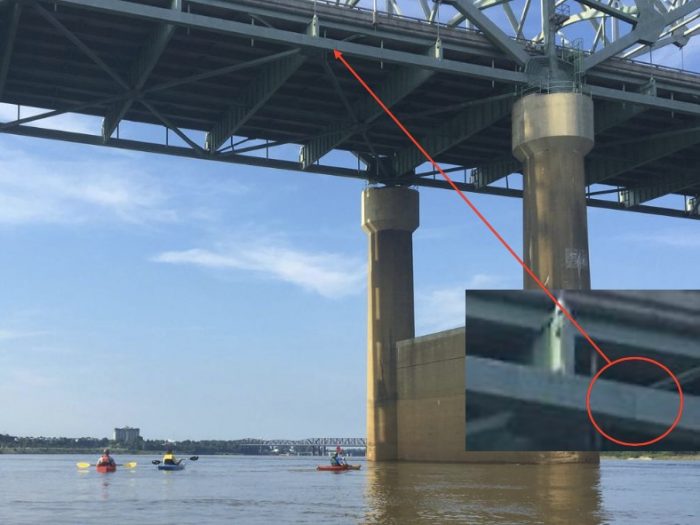
An early warning
In 1978, just five years after the I-40 bridge opened, state transportation officials across the country received a warning from the Federal Highway Administration: Tied arch bridges were susceptible to weld cracks. A technical advisory said such bridges “should be inspected carefully, especially the tie girders.”
“The serious consequences of weld cracking associated with the tie girder of a tied arch structure should not be overlooked,” the federal advisory said. “Repairs to rectify the above fractures have been very costly, time consuming and in many cases have inconvenienced the traveling public.”
The WJE report notes that at least two tied arch bridges experienced weld cracking in their tie girders in the late 1970s and early 1980s — the I-24 bridge in Paducah, Ky. and the I-29 bridge in Neville Island, Penn. Such concerns prompted the Tennessee Department of Transportation to search the bridge for welding defects in 1982 using ultrasonic testing, according to Kniazewycz, the Tennessee transportation official.
The ultrasonic test identified a one-inch-long defect in weld number NB222W, the bad weld where the fracture would one day develop. The defect was labeled as “slag,” a normal by-product of the welding process. But the test somehow missed two large hydrogen cracks in the repaired portion of the weld, just a few inches away.
Kniazewycz said the hydrogen cracks were likely missed because the weld, having been repaired during fabrication, was wider than other welds on the tie girder.
“They’ll measure from a known point and they know where the weld is supposed to be. That’s where they’ll scratch off the paint and do the testing. But what they didn’t know is that this weld was repaired in the shop, and thus it was a lot bigger,” he said.
That’s the Tennessee agency’s conclusion, he said, not WJE’s. “We don’t know for a fact, and neither do they,” he said.

Raymond Tillman, a licensed professional engineer and past president of a division of the American Road and Transportation Builders Association, said two errors seem to have been made in regard to the 1982 testing.
“Number one, they understated the potential of the problem. And two, they didn’t prescribe follow-on inspections. Or if they did prescribe them, it wasn’t followed,” he said.
“After 1982, they should have said, ‘Whoops, we don’t really know how it will deteriorate, so let’s keep our eye on any potential cracking at the location of field welds.’ Those field welds should have been examined close up since 1982,” Tillman said.

More warnings
In 2011, the Federal Highway Administration issued another technical advisory with implications for the I-40 bridge. The federal agency warned state transportation departments that bridges fabricated from a certain grade of steel known as “T-1” were especially prone to hydrogen cracking. T-1 steel was used to construct the I-64 Sherman Minton Bridge in Louisville, Ky., which was shut down in 2011 after inspectors found extensive cracking in welds on the tie girder. It was also used on the I-40 bridge.
The Sherman Minton Bridge, which crosses the Ohio River, resembles the I-40 bridge in several ways. Both are made of two tied arch truss main spans of similar length. They were constructed about a decade apart — the Sherman Minton Bridge opened in 1962, the I-40 bridge in 1973.
Both were built with T-1 steel at a time before the development of fracture control plans to prevent hydrogen cracking within welds. And both are “fracture critical,” meaning they lack redundancies intended to prevent a collapse in the event of a key component failing, such as a tie girder.
The 2011 federal advisory told states they should check the soundness of welds in tie girders made of T-1 steel. It specifically recommended using ultrasonic testing or a similar method, “unless this verification has been previously conducted.”
But the I-40 bridge had already been tested, back in 1982.
“While [ultrasonic testing] was not required on this bridge in 2012 by [the Federal Highway Administration], in hindsight it would have definitely increased our ability to discover the flaws that were previously undetected,” Parker, the ArDOT spokesman, said.
ArDOT did at least establish a written inspection protocol for the I-40 bridge in 2012. The brief document notes that cracks have been found in the welds of other tied arch spans in the past and references the 1982 ultrasonic testing. “Close visual examinations are made of these welds during each inspection,” it says. But, at 200 words, it provides few details about how inspections should take place.
Tillman said the failure to properly inspect the welds illustrated the importance of having a licensed professional engineer on site during a bridge inspection. ArDOT did not require an engineer to be part of the inspection team on the I-40 bridge during past inspections.
“An inspector says, ‘We went out there and spent some time, and I didn’t see anything,’ and that’s the end of it,” Tillman said. “A professional engineer would have looked more closely and related it to problems in other bridges. A professional engineer should have been aware of the ultrasonic studies that indicated something in 1982 and said, ‘We’ve really got to look at this more closely.’ That’s why you put critical, competent people in the right positions.”
Parker said ArDOT will have a professional engineer on site during future inspections of “complex/major bridges,” as recommended by the recent Federal Highway Administration review of the agency’s policies.
Oversight increased
ArDOT has replaced the leadership of its “heavy bridge maintenance” section, which oversees inspections of major structures like the I-40 bridge. It now requires a professional engineer on site for such inspections. It’s added a fourth statewide inspection team, expanded its use of drones, and recently helped 29 ArDOT professional engineers become certified to be team leads for inspections, according to Parker.
Broader policy changes are ongoing, and the Federal Highway Administration “has and will continue to remain active in assisting ARDOT in strengthening the Bridge Inspection Program through ongoing correspondence and period progress meetings,” Parker said.
The near-disaster has had national consequences. On Dec. 13, the Federal Highway Administration issued an “action memo” referencing the I-40 bridge and requiring state transportation departments to use ultrasonic testing methods to search for weld problems on bridges with similar vulnerabilities.
“A State DOT’s [Department of Transportation’s] failure to take the above actions could unreasonably put such structures at risk of failure and may result in liability for the State DOT in the event of failure,” the memo warned.
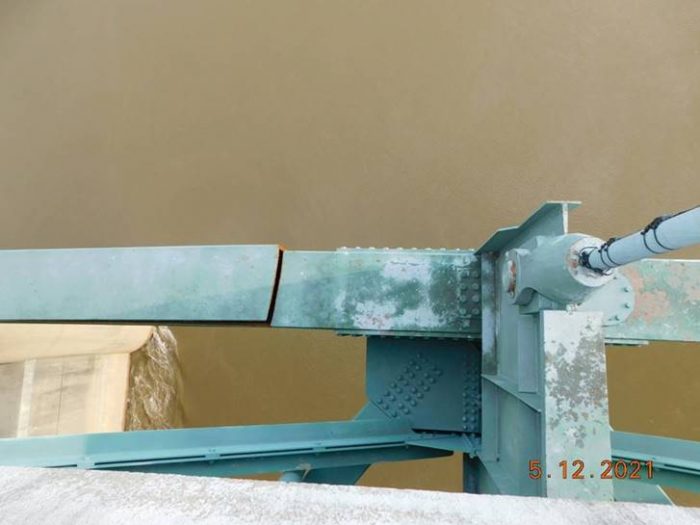
Today, the I-40 bridge is likely safer than it has been in years. The WJE report says it is theoretically possible but “highly unlikely” another major fracture could occur at a tie girder weld. But, it continues, “It is prudent to continue regular biannual arms-length fracture critical inspections with ultrasonic testing performed on a periodic (≈10 years) basis.”
Parker said ArDOT planned to follow that recommendation.
On the brink
Despite all the investigation, some questions may never be answered.
One is when the fracture grew from a small, hidden weld defect into a large, visible fracture. Another is what exactly triggered it to start growing.
When metals are stressed repeatedly, they gradually become weaker, and most engineers initially assumed “metal fatigue” played a major role in the development of the I-40 crack. But the WJE analysis found no evidence of fatigue.
Instead, it says the crack propagated due to “an unknown combination of tie girder loading which likely included thermal effects in combination with live loads.”
In engineering language, “loading” simply means a force or pressure placed on a structure. A “live load” is traffic — the weight of the cars and trucks cycling over the bridge. “Thermal effects” refers to stresses due to cooling and heating of the steel, especially during cold weather.
Adel Abdelnaby, an associate professor of engineering at the University of Memphis, said he was not satisfied with WJE’s explanation. “We still don’t know what the loading conditions were,” he said. “So we need more investigation on what exactly happened. That’s the problem. It’s a bridge that affects the lives of so many people, so you have to be sure.”
Parker, the ArDOT spokesman, said the agency “cannot identify a specific event that caused the crack to propagate. For example, a high live load could be fully loaded (legal weight) trucks in all 6 lanes crossing the midspan of the bridge at the exact same time.”
Whatever triggered the crack to grow, one thing is certain: The Memphis region got incredibly lucky.
Newer bridges are built with higher redundancy, meaning they are less reliant on any individual element. With a high-redundancy bridge, Abdenaby said, “if one part fails, there may be problems, but the whole bridge doesn’t collapse. If something fails, something else is going to take over.”
But the I-40 bridge is a low-redundancy bridge. “If this tie girder [completely] fractures, you’re supposed to have the bridge collapse. The whole bridge, right away,” he said. Somehow, the remaining portion of the tie girder managed to keep supporting the span, he said, despite the fact that it was more than halfway severed.
Parker said the arch spans were designed with “a high factor of safety,” meaning they were built to be much stronger than would be needed under normal circumstances.
Prinz said designers make conservative assumptions about the strength of materials, especially in fracture critical members.
“On paper, yes, maybe this thing was compromised. But in reality, the structure is a little bit smarter than we are,” he said. “Steel is a very resilient material.” It’s also possible that other elements of the bridge may have “picked up the slack” from the girder, he said, providing an alternate load path.
In other words, the I-40 bridge proved to be more resilient than expected. But it’s impossible to know just how long the deteriorating girder would have held up.
“We were very fortunate,” Prinz said.
This reporting is courtesy of the Arkansas Nonprofit News Network, an independent, nonpartisan news project dedicated to producing journalism that matters to Arkansans, and is supported in part by a grant from the Fund for Investigative Journalism. This story was co-published with The Daily Memphian.